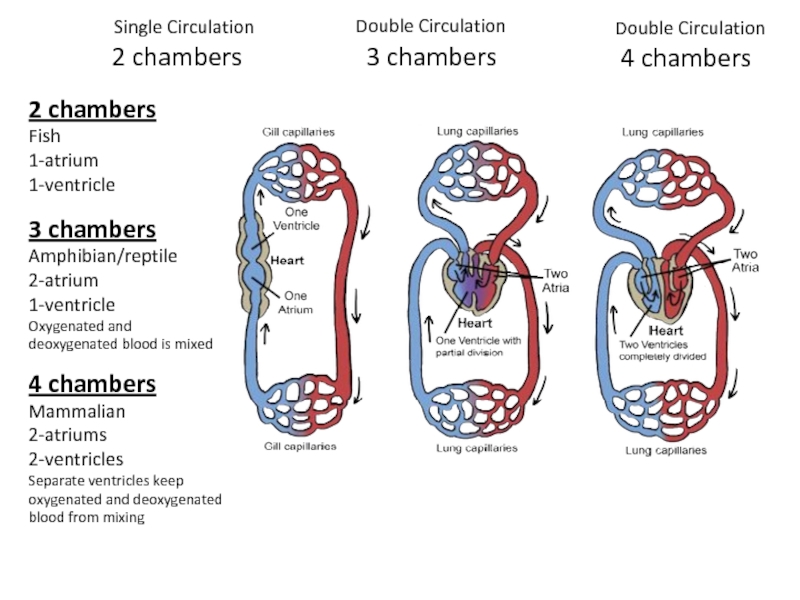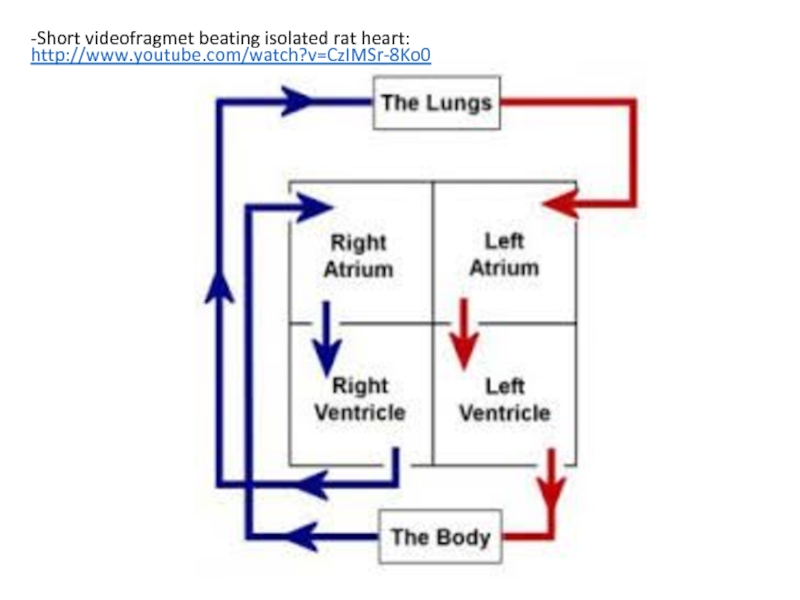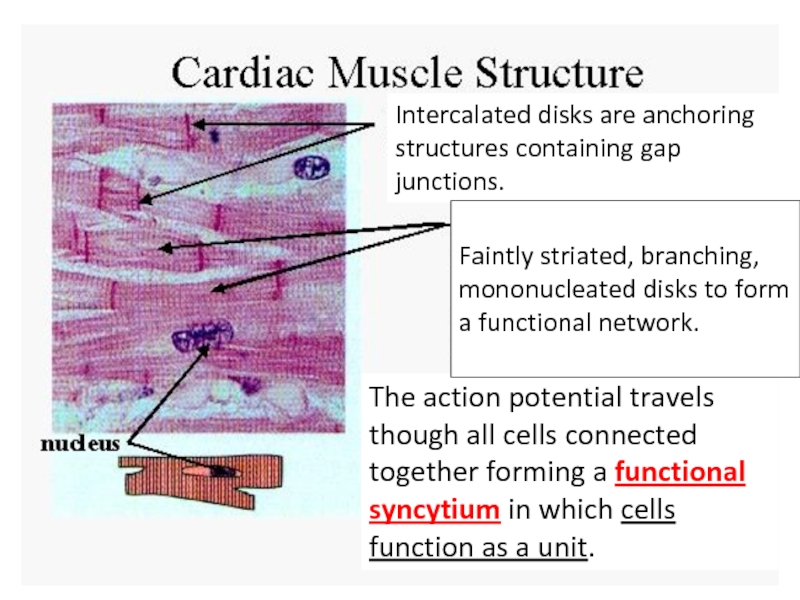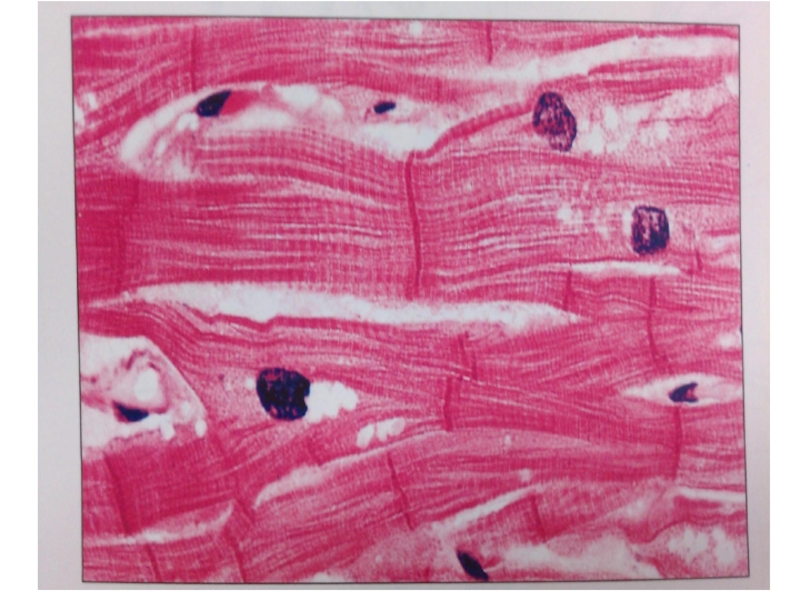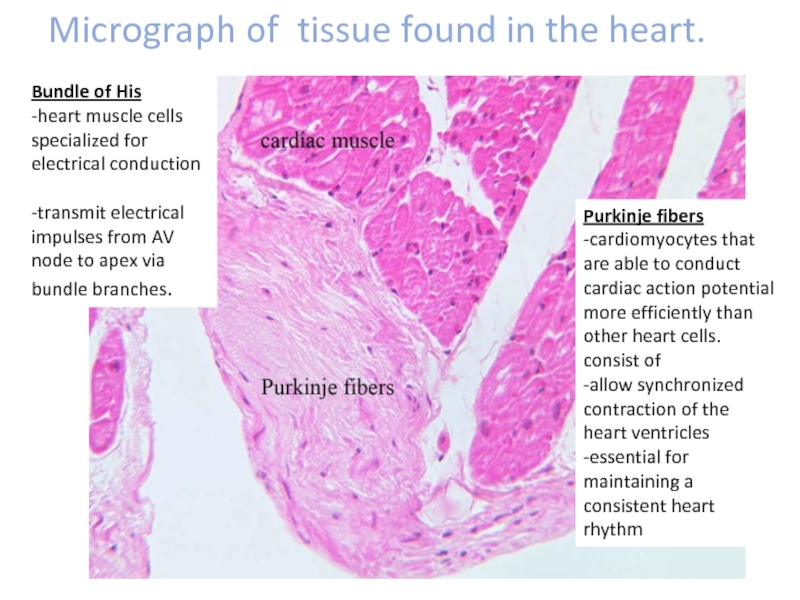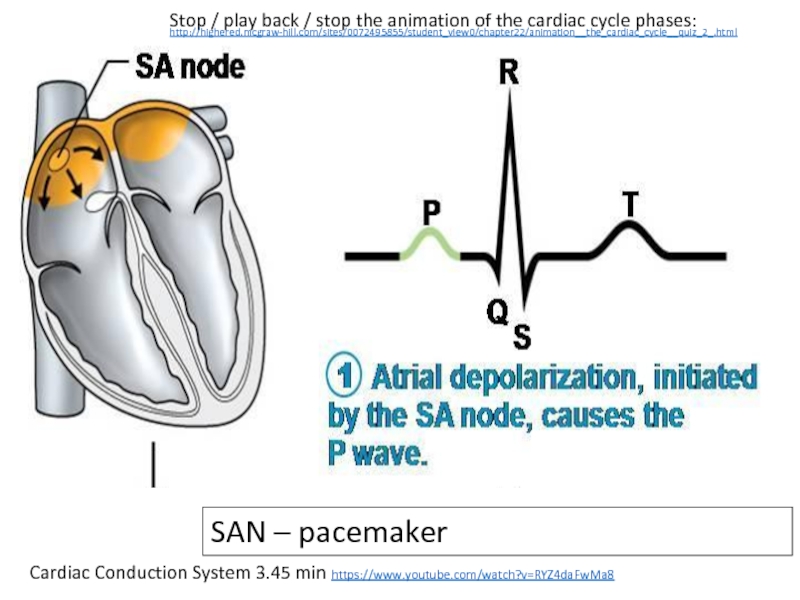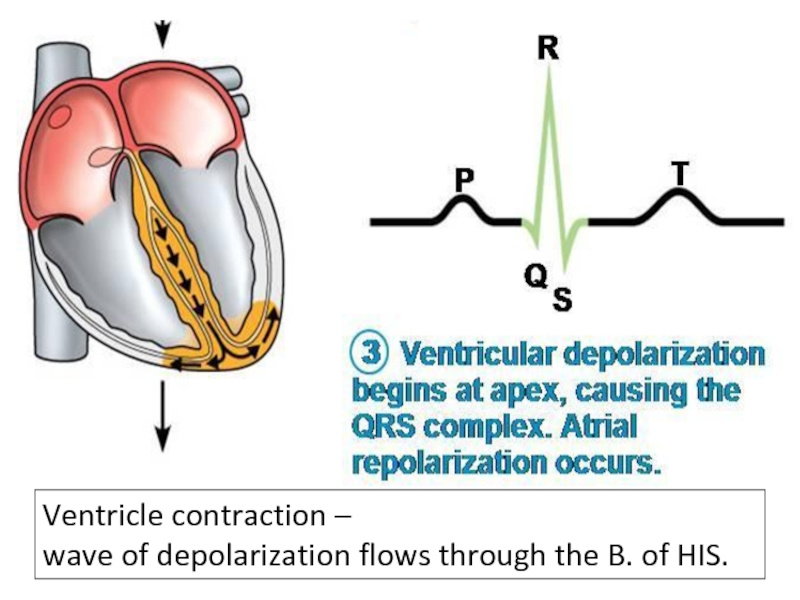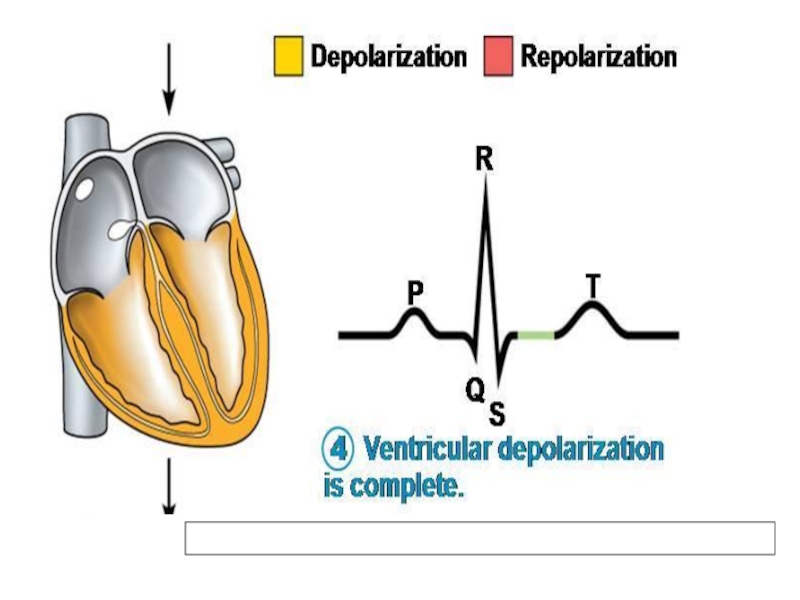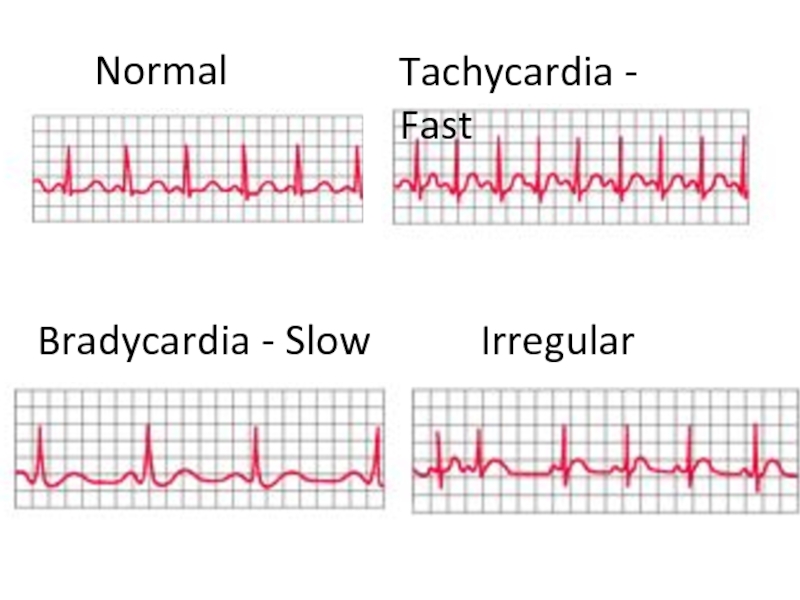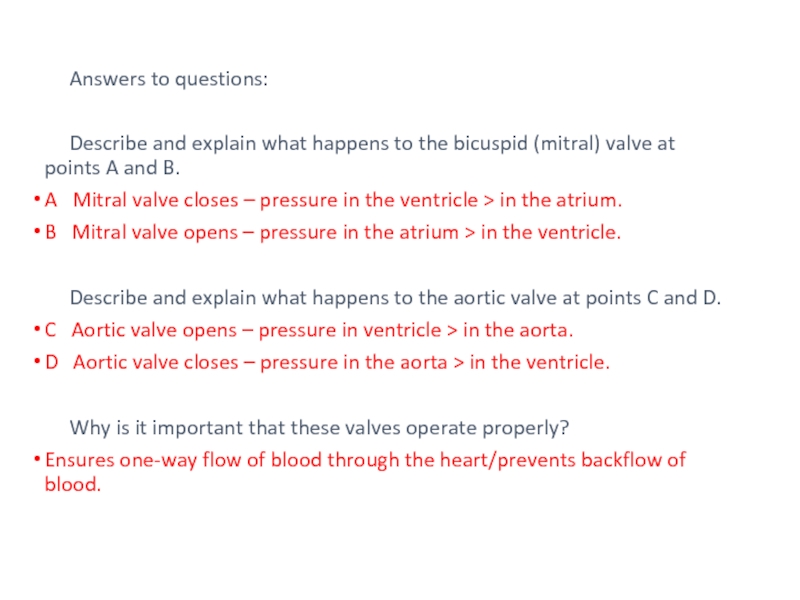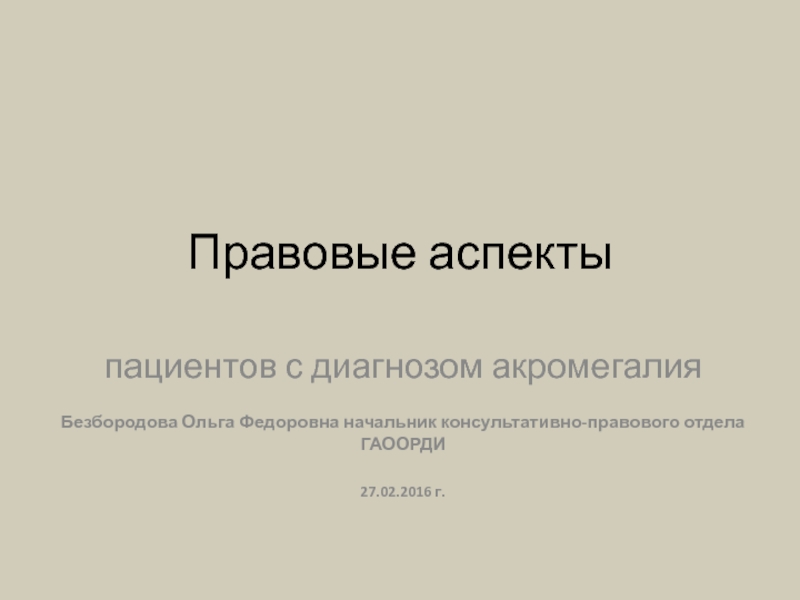Слайд 1Electrical Processes of the Heart
G11 Biology 2017-2018
Learning Objective:
Explain the mechanism
of cardiac automaticity.
Use and electrocardiogram to describe the cardiac cycle.
Success Criteria
Investigate the electrical process of in the heart .
Describe the structure of the heart and indicate the link between the structure of the heart muscles and its ability to automaticity.
Explain the mechanism of heart automaticity.
Explain the essence of ElectroCardioGraphy (ECG)
CIE Biology Jones
pp 173-179
Extra For Students
A level notes https://alevelnotes.com/The-Mammalian-Heart/171
Mrs Cooper – 4 videos
https://www.youtube.com/watch?v=X9B6dfzlvBQ
Слайд 2Terminology 1 – Cardiac Mechanism
https://quizlet.com/173937887/chapter-7-cardiac-cycle-conduction-system-of-the-heart-flash-cards/
Flash Cards
Слайд 32 chambers
3 chambers
2 chambers
Fish
1-atrium
1-ventricle
4 chambers
3 chambers
Amphibian/reptile
2-atrium
1-ventricle
Oxygenated and
deoxygenated blood is mixed
4 chambers
Mammalian
2-atriums
2-ventricles
Separate ventricles keep oxygenated and deoxygenated blood from mixing
Single Circulation
Double Circulation
Double Circulation
Слайд 4Blood travels through the heart twice before returning to the body
Double
Circulatory
System
Слайд 5
Heart Double Pump
Pulmonary – lungs
Systemic - body
Слайд 6-Short videofragmet beating isolated rat heart:
http://www.youtube.com/watch?v=CzIMSr-8Ko0
Слайд 7Voluntary Striated
Multinucleated
Non-branched
Involuntary Non-striated
Mononucleated Tapered
Involuntary Striated
Intercalculated disks
Mononucleated Branched
Three Types of Muscle Tissue Draw and Label
Слайд 8
The action potential travels though all cells connected together forming a
functional syncytium in which cells function as a unit.
Intercalated disks are anchoring structures containing gap junctions.
Faintly striated, branching, mononucleated disks to form a functional network.
Слайд 10Define the following terms
Functional syncytium –the heart consists of individual cells,
the entire mass normally responds as a unit and all of the cells contract together.
Myogenic – cardiac muscle can contract without nervous input. BUT the strength and the rate of contraction is modified by nervous input.
Automaticity – the cardiac cell’s ability to spontaneously generate an electrical impulse (depolarize).
Слайд 11The heart is myogenic – it contracts on its own without
stimulus from the nervous system.
But, the heart RATE is controlled by the nervous system
Accelerator nerve (sympathetic NS)
- When stimulated releases neurotransmitter at the SA node to increase the heart rate
Vagus nerve
(parasympathetic NS)
-when stimulated releases neurotransmitter to at the SA node to DECREASE the heart rate.
Слайд 12Heart Function- More definitions
Aorta-is connected to the left ventricle and carries
oxygenated blood to all the parts of the body except the lungs.
Vena cava – is connected to the right atrium and brings deoxygenated blood back from the tissues.
Pulmonary artery – is connected to the right ventricle and carries deoxygenated blood to the lungs, where oxygen is replenished and carbon dioxide is removed.
Pulmonary vein – is connected to the left atrium and brings oxygenated blood back from the lungs.
Слайд 14External Features-Label
Superior
Inferior
Left
Right
Слайд 15
Transverse section of the heart apex
-Left ventricle is thicker because
it needs to pump blood all the way around the body, whereas the right ventricle only has to get blood to the lungs.
Septum
Right Ventricle
Left Ventricle
Слайд 17Deoxygenated blood from body to RA through vena cava
Blood from RA
to RV through tri-cuspid valve
Oxygenated blood to all the cells in the body via aorta
Deoxygenated from RV through pulmonary arteries to lungs to get oxygen
Oxygenated blood returns to LA via pulmonary veins.
Oxygenated blood to LV via the bi-cuspid valve.
The path of blood through the heart
Blood flow steps
Слайд 18
Chordae tendinae- prevent the valves from turning inside out under pressure.
4 Valves of the heart, open only one way
-high pressure behind – open
-high pressure in front – closed.
Tricuspid
valve
Tricuspid
valve
Pulmonary valve
Aortic Valve
Mitral Valve (bicuspid)
Mitral Valve (bicuspid)
Слайд 19
Chordae tendinae- prevent the valves from turning inside out under pressure
https://img-s3.onedio.com/id-586dc25e8af48d87160028dc/rev-0/raw/s-38552e457ef8be1d75f2e890341c6b74d906a440.gif
Animation
4 Valves
Слайд 20II. Cardiac Cycle
http://en.wikipedia.org/wiki/File:ECG_principle_slow.gif
--Animation showing a cardiac cycle and the corresponding electrocardiogram
wave http://en.wikipedia.org/wiki/File:ECG_principle_slow.gif
Information on the ECG and examples of some common anomalies
http://www.ivline.info/2010/05/quick-guide-to-ecg.html
http://www.happydoctor.ru/info/536
Слайд 23Aorta – Leaves the left ventricle and distributes oxygenated blood (through
systemic circulation) to the body
Pulmonary Arteries – Leave right ventricle and carries deoxygenated blood from the heart to the lungs (through pulmonary circulation)
Vena Cava – Enters right atrium, delivering deoxygenated blood from the body. The Superior Vena Cava (blood from upper body) and the Inferior Vena Cava (blood from lower body)
Pulmonary Veins – Enter left atrium, receiving oxygenated blood from the lungs
left ventricle 4) vena cava 7) right atrium
2) pulmonary artery 5) aorta 8) pulmonary vein
3) left atrium 6) right ventricle
9) atrio-ventricular (tricuspid) valve 10) semi-lunar (aortic) valve
99
5 aorta9
39
79
19
69
2 Pulmonary Artery9
8 Pulmonary VEINS9
8 Pulmonary VEINS9
2 Pulmonary Artery9
Arteries carry blood AWAY from the HEART Veins carry blood TOWARD the HEART
4 superior VC9
4 inferior VC9
109
Слайд 24What is myogenic?
muscles or tissues that can contract on their own,
without any external electrical stimulus from the brain or nervous system.
Слайд 25Electrical Activity of the Heart
Electrical Activity of the Heart 1.0 min
https://www.youtube.com/watch?v=te_SY3MeWys
1-
SAN node
2 – AV node
3 - Bundle of HIS
4 – Right / Left
Branch Bundles
5 - Purkinje fibers
Your text here
Names of the numbers!
Electrical Activity 3 min https://www.youtube.com/watch?v=RYZ4daFwMa8
Слайд 26Micrograph of tissue found in the heart.
Bundle of His
-heart muscle cells
specialized for electrical conduction
-transmit electrical impulses from AV node to apex via bundle branches.
Purkinje fibers
-cardiomyocytes that are able to conduct cardiac action potential more efficiently than other heart cells. consist of
-allow synchronized contraction of the heart ventricles
-essential for maintaining a consistent heart rhythm
Слайд 27Atrioventricular valves- link the atria to the ventricles.
Semi-lunar- valves link the
ventricles to the pulmonary artery and aorta
Bundle of His -heart muscle cells specialized for electrical conduction -transmit electrical impulses form AV node to apex via bundle branches.
Purkinje fibers -cardiomyocytes that are able to conduct cardiac action potential more efficiently than other heart cells. consist of
-allow synchronized contraction of the heart ventricles
-essential for maintaining a consistent heart rhythm
Слайд 28
Rest:
(=)+ outside - inside
Depolarization:
(=) - outside + inside
Repolarization:
Returns to:
+ outside - inside
Слайд 30Describe the difference between polarisation, depolarisation and repolarisation.
Sarcolemma –resting potential
IONS INVOLVED
- K+, Na+ and Ca+ (from sarcoplasmic reticulum)
Слайд 31depolarization…..
Depolarization is when a cell membrane's charge becomes positive to
generate an action potential. This is usually caused by positive sodium and calcium ions going into the cell
Слайд 32repolarization…..
Repolarization is when a cell membrane's charge returns to negative after
depolarization. This is caused by positive potassium ions moving out of the cell.
Depolarization and repolarization video
http://www.youtube.com/watch?v=4vkbywows-o
Слайд 33The QRS complex
the combination of three of the graphical deflections
seen on a typical deflections on an electrocardiogram = ECG or EKG
Слайд 35
Cardiac Conduction System 3.45 min https://www.youtube.com/watch?v=RYZ4daFwMa8
SAN – pacemaker
Stop / play back / stop the animation of the cardiac cycle phases: http://highered.mcgraw-hill.com/sites/0072495855/student_view0/chapter22/animation__the_cardiac_cycle__quiz_2_.html
Слайд 36
0.2 seconds -- time for the impulse to be conducted from
the SAN to the ventricles via the AVN (P—R). The edges of the atria have tough fibers that prevents the leakage of impulse from atrias. AVN - gatekeeper
Слайд 37
Ventricle contraction –
wave of depolarization flows through the B. of
HIS.
Слайд 41What are some ways that SAN and AVN control the heart
beat?
Слайд 42-SAN initiates heartbeat
-Beat of heart is myogenic – spontaneous not started
by nervous system stimulus
-Rate of heartbeat is influenced by nervous system
-Wave of electrical activity, impulses over atria triggers contraction of atrium
-Electrical activity may only pass to the ventricles via AVN and bundle of HIS (septum)
-Fibrous tissue prevents passage beyond atria
-Delay at AVN allows ventricles to fill completely from atria
FACTS
Слайд 43EKG wave animation..
http://en.wikipedia.org/wiki/Electrocardiography#mediaviewer/File:ECG_principle_slow.gif
Слайд 44EKG or ECG - Electrocardiography
Слайд 45During the cardiac cycle (one contraction of the heart plus the
relaxation period that follows), electrical changes take place in the heart. These changes can be visualized and recorded.
Detection of electrical forces in the heart.
Electrical forces in the heart can be detected on the body's surface. Therefore, electrodes attached to the patient's skin can detect electrical forces in the heart.
2) Recording of electrical forces in the heart.
The recording of the electrical changes during the
cardiac cycle is called an electrocardiogram (ECG
or EKG). The instrument used to record these
changes is an electrocardiograph.
Слайд 46(1) P wave. A small upward (positive) wave that indicates atrial polarization (the
spread of an impulse from the SA node through the muscle of the two atria). The atria contract a fraction of a second after the P wave begins.
(2) QRS wave (complex).
This second wave begins as a
downward deflection and
continues as a large, upright,
triangular wave which finally
ends as a downward wave at
its base. This wave complex
shows the spread of the
electrical impulse through the ventricles.
(3) T wave. The third wave shows ventricular repolarization.
NOTE: There is no deflection to show atrial repolarization because the stronger QRS wave masks this event.
Слайд 47
http://www.ivline.org/2010/05/quick-guide-to-ecg.html#at_pco=smlre-1.0&at_si=5420a7df299cca88&at_ab=per-2&at_pos=0&at_tot=4
Слайд 48Ventricular fibrillation
What do you think is happening in the ECG?
Heart
Block
Слайд 49Ventricular fibrillation
What do you think is happening in the ECG?
Heart
Block
Uncontrolled contraction of the ventricles causes little blood to be pumped
Ventricles are not always stimulated
Слайд 50Match the beat with the ECG.
Tachycardia
Irregular
Normal
Bradycardia
Слайд 51Tachycardia - Fast
Irregular
Normal
Bradycardia - Slow
Слайд 52Wolff-Parkinson-White (WPW) Syndrome
An extra electrical pathway between your heart's upper and
lower chambers causes a rapid heartbeat. The extra pathway is present at birth and fairly rare.
WPW syndrome is defined as a congenital condition involving abnormal conductive cardiac tissue between the atria and the ventricles that provides a pathway for a reentrant tachycardia circuit
The accessory bridge is called the bundle of Kent. It runs along the wall of the the left ventricle.
Слайд 53Wolff Parkinson Wright Syndrome (WPW)
-Write information from the video and label
the 2nd heart on your worksheet.
-Record the information of the electrical circuit of WPW
Accessory pathway Bundle of Kent
https://www.youtube.com/watch?v=9MDRKId2d0Q
Normal
Wolff Parkinson White Syndrome
Слайд 57atrio-ventricular valves open
atrio-ventricular valves close
semi-lunar
valves open
semi-lunar
valves close
Слайд 59Match the letter on the graph to the following events
______Semi-lunar valves
open
______Atrio-ventricular valves close,
______Semi-lunar valves close
______Atrio-ventricular valves open
Слайд 60atrio-ventricular valves open
atrio-ventricular valves close
semi-lunar
valves open
semi-lunar
valves close
Слайд 61A Atrioventricular (bicuspid / mitral) valve(s) closes (“snaps shut”– makes 1st
louder heart sound “LUB”
B Semilunar valve(s) (aortic valve) opens
C Semilunar valve(s) closes – makes second softer heart sound “DUB”- shut due to blood accumulating in their pockets
D Atriioventricular (bicuspid) valve(s) opens
“LUB”
“DUB”
Atrial
Systole
Ventricular
Systole
Diastole
How to calculate
the cardiac cycle
Beats per minute
(bpm).
1 minute (60s)
Length one cycle
C
D
B
Слайд 62https://www.youtube.com/watch?v=RYZ4daFwMa8
Electrical activity in heart
https://www.twig-bilim.kz/film/heart-976/ - Revision of structure and function
On your
own electrical one 7 min
https://www.youtube.com/watch?v=zBj6btjdYHU
You tube clips to down load or watch
THE HEART – Electrical activity, ECG
and EEG
https://www.youtube.com/watch?v=8aLufvkRw-k - Shows the heart and ecg trace
https://www.youtube.com/watch?v=bO-_ZtIxcr0 – Showing how EEG is done
https://www.youtube.com/watch?v=HX7L11rhRTw – Diagnosing epilepsy. Interesting.
Слайд 64Tachycardia
Increased heart rate is a normal response to:
exercise
excitement
stress
drugs
e.g. caffeine, nicotine, amphetamine (speed).
Tachycardia is elevated heart rate for no reason.
Sometimes heart rate is so high that little blood is actually pumped:
filling time too short.
Treatment might involve:
relaxation therapy
β-blocker.
Normal – for reference
Tachycardic
6 beats per 5 seconds =
9 beats per 5 seconds =
72 bpm
108 bpm
Слайд 65Bradycardia
Pattern of electrical activity is normal but slow.
Reduced heart rate could
indicate:
good aerobic fitness (elite athletes like Steve Redgrave have resting heart of ca. 45 bpm).
Alternatively might be caused by drugs:
tranquilisers
β-blocker.
Cause may need investigation:
stagnation
risk of blood clots.
Normal – for reference
Bradycardic
6 beats per 5 seconds = 72 bpm
4 beats per 5 seconds = 48 bpm
Слайд 66Heart block
There is separation of the P wave and the QRS
complex.
Pacemaker activity and atrial contraction is normal.
Delay in conduction between atria and ventricles.
Normal – for reference
Heart block
6 beats per 5 seconds = 72 bpm
Dissociated P and QRS complex
Слайд 67Fibrillation
Contraction of cardiac muscle is normally coordinated.
In VF the ventricles contract,
but it is not coordinated:
fluttering
little blood is pumped.
Defibrillation may work:
heart is shocked
heart stops
when it restarts, it may do so with a normal rhythm.
Normal – for reference
Ventricular fibrillation (VF)
6 beats per 5 seconds = 72 bpm
Uncoordinated and weak contraction
Слайд 68Cardiac Cycle
General Principles.
Contraction of the myocardium generates pressure changes
which result in the orderly movement of blood.
Blood flows from an area of high pressure to an area of low pressure, unless flow is blocked by a valve.
Events on the right and left sides of the heart are the same, but pressures are lower on the right.
Слайд 69Atrial systole
The heart is full of blood and the ventricles are
relaxed
Both the atria contract and blood passes down to the ventricles
The atrio-ventricular valves open due to blood pressure
70% of the blood flows passively down to the ventricles so the atria do not have to contract a great amount.
Слайд 70Ventricular systole
The atria relax.
The ventricle walls contract, forcing the blood out
The
pressure of the blood forces the atrio-ventricular valves shut (producing the heart sound ‘lub’)
Слайд 71Ventricular systole
The pressure of blood opens the semi-lunar valves.
Blood passes into
the aorta and pulmonary arteries.
Слайд 72Diastole
The ventricles relax
Pressure in the ventricles falls below that in the
arteries
Blood under high pressure in the arteries causes the semi lunar valves to shut. This produces the second heart sound, ‘dub’.
During diastole, all the muscle in the heart relaxes.
Слайд 73
Blood from the vena cava and pulmonary veins enter the atria.
The
whole cycle starts again.
Слайд 74Match the letter on the graph to the following events
______Semi-lunar valves
open
______Atrio-ventricular valves close,
______Semi-lunar valves close
______Atrio-ventricular valves open
Слайд 75atrio-ventricular valves open
atrio-ventricular valves close
semi-lunar
valves open
semi-lunar
valves close
Слайд 76A Atrioventricular (bicuspid / mitral) valve(s) closes (“snaps shut”– makes 1st
louder heart sound “LUB”
B Semilunar valve(s) (aortic valve) opens
C Semilunar valve(s) closes – makes second softer heart sound “DUB”- shut due to blood accumulating in their pockets
D Atriioventricular (bicuspid) valve(s) opens
“LUB”
“DUB”
Atrial
Systole
Ventricular
Systole
Diastole
How to calculate
the cardiac cycle
Beats per minute
(bpm).
1 minute (60s)
Length one cycle
C
D
B
Слайд 77Examine the graph that shows pressure changes in the left ventricle,
left atrium and aorta. Then answer the questions:
What is the maximum pressure reached in the left ventricle?
Why is the maximum pressure in the left atrium lower?
What is the length of one cardiac cycle?
Using the length of cardiac cycle, what is the pulse rate in bpm? Show your working out.
Describe and explain what happens to the aortic valve at points C and D.
Describe and explain what happens to the bicuspid (mitral) valve at points A and B.
Why is it important that these valves operate properly?
Answer the following questions using your notes and the given graph!
Слайд 78 Answers to questions:
What is the maximum pressure reached in the left
ventricle?
16 kPa. Corresponds to ventricular systole – contraction of the left ventricle reduces ventricle volume and so increases pressure.
Why is the maximum pressure in the left atrium lower?
Left atrium muscle is much thinner, so cannot generate as much pressure. Does not need to pump the blood very far.
What is the length of one cardiac cycle?
Approximately 0.75 s
Using the length of cardiac cycle, what is the pulse rate in bpm? Show your work!
60/0.75 = 80 bpm
Слайд 79 Answers to questions:
Describe and explain what happens to the bicuspid (mitral)
valve at points A and B.
A Mitral valve closes – pressure in the ventricle > in the atrium.
B Mitral valve opens – pressure in the atrium > in the ventricle.
Describe and explain what happens to the aortic valve at points C and D.
C Aortic valve opens – pressure in ventricle > in the aorta.
D Aortic valve closes – pressure in the aorta > in the ventricle.
Why is it important that these valves operate properly?
Ensures one-way flow of blood through the heart/prevents backflow of blood.
Слайд 81 Electrical Activity In The Heart. The heart's electrical activity begins in the
sinoatrial (SA) node and flows toward the ventricles via internodal pathways. From the AV node impulses are conducted along the Bundle of His and then along the Purkinje fibers.
The SA node is the heart's pacemaker. All the areas of this conduction system initiate impulses, become irritable, and respond to an impulse. Impulses are initiated in each area of the conduction system as shown above.
Слайд 82How does the structure of cardiac muscle differ from cardiac muscle?
Only
know (a)
Слайд 83For interest – Data response
Name the ions involved in cardiac muscle
contraction.
Where does the action potential originate from?
How do you think the contraction of cardiac muscle differ from that of striated muscle?


